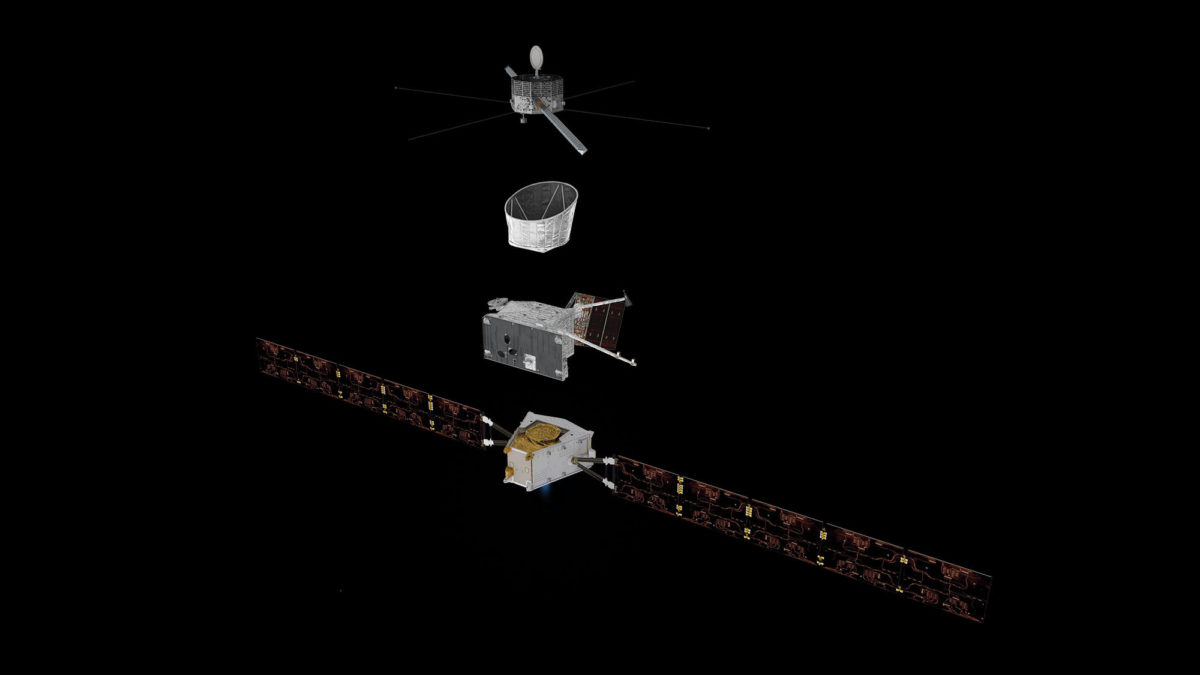BepiColombo, studying how Mercury formed
Highlights
- BepiColombo is a joint European-Japanese mission to explore the planet Mercury. It launched in 2018 and will enter Mercury orbit in 2025.
- BepiColombo is composed of three separate spacecraft that blasted off from Earth together.
- The mission will study water ice at Mercury’s poles and the planet’s abnormally large core. This will ultimately help us learn how Mercury formed, and what the early solar system was like.
Why study Mercury?
Despite being the closest planet to the Sun with surface temperatures of 430 degrees Celsius (800 degrees Fahrenheit), Mercury has water ice hidden in shadowed craters near its poles. The planet’s surface appears old and cratered, undisturbed by geologic activity like volcanoes. Yet it has a magnetic field, which is normally caused by a molten core that should, in turn, cause surface changes.
These apparent contradictions make Mercury as intriguing as any other planet in our solar system, yet only two missions (NASA’s Mariner 10 and MESSENGER) have ever studied it up close. MESSENGER discovered Mercury’s core makes up 85% of the planet’s volume—much more than Earth’s, which is just 15%.

What's the plan for BepiColombo?
Why does Mercury have such a large core, and how does it generate the planet’s magnetic field? These are questions that BepiColombo, a joint Japanese-European Mercury mission that launched in 2018, will attempt to answer. BepiColombo will arrive in Mercury orbit in 2025.
How did the planets form, and what was the early solar system like when life arose on Earth? To answer these questions, scientists need to understand all the diverse types of worlds around our Sun, including Mercury. By understanding how Mercury came to be and unraveling its enigmatic nature, we will be one step closer to understanding where we came from.
Where does the name BepiColombo come from?
BepiColombo is named in honor of Giuseppe “Bepi” Colombo (1920-1984), an Italian mathematician-engineer who explained Mercury rotating three times for every two orbits around the Sun. Colombo also calculated how NASA’s Mariner 10 spacecraft could fly past Venus, using the planet’s gravity to set a course for Mercury in the 1970s.
BepiColombo’s journey to Mercury On its 7-year journey to Mercury, the European-Japanese mission BepiColombo takes advantage of the gravity of Earth, Venus and Mercury to adjust its trajectory and reach its final orbit. Credit: ESA - European Space Agency, CC BY-SA 3.0 IGO
How BepiColombo will explore Mercury
Before BepiColombo can study Mercury, it faces a long journey. Mercury is the fastest orbiting planet in our solar system—it blazes around the Sun at 48 kilometers per second. To reach Mercury, the spacecraft performed several gravity-assist flybys to pick up speed, passing the Earth in April 2020, Venus in 2020 and 2021, and Mercury six times between 2021 and 2025.
BepiColombo is actually three spacecraft that launched together as a combined vehicle.
- Mercury Planetary Orbiter (MPO): This spacecraft, built by the European Space Agency, has 11 science instruments that will study Mercury’s surface, interior structure, composition, atmosphere, and magnetic field.
- Mercury Magnetospheric Orbiter (MMO): Nicknamed “Mio,” this spacecraft, built by the Japan Aerospace Exploration Agency, carries instruments mostly dedicated to the study of Mercury’s magnetic field, as well as the space environment around Mercury.
- Mercury Transfer Module (MTM): This spacecraft, built by ESA, carries the propulsion system that will get all 3 spacecraft to Mercury.
Once all three spacecraft arrive at Mercury in 2025, MPO and MMO will split off into two different orbits best suited to their science instruments. MPO will orbit close to Mercury where it can observe the planet’s surface best, while MMO will stay farther back where it can study the planet’s magnetic field.
Support missions like BepiColombo
Whether it's advocating, teaching, inspiring, or learning, you can do something for space, right now. Let's get to work.


 Explore Worlds
Explore Worlds Find Life
Find Life Defend Earth
Defend Earth


